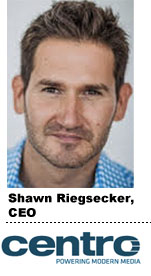 “Workflow” is not the sexiest of topics, even in the realm of digital advertising. But as the process of buying, planning and tracking digital ad buys gets more complex, both agencies and software companies are taking a more serious look at what can and should be automated.
“Workflow” is not the sexiest of topics, even in the realm of digital advertising. But as the process of buying, planning and tracking digital ad buys gets more complex, both agencies and software companies are taking a more serious look at what can and should be automated.
Several months ago, Mediaocean, which was the product of a merger between the 40-year-old media buying and relative workflow upstart MediaBank, began turning its attention away from traditional TV ad sales and towards display with its Prisma system. Last month, one of the other major media buying workflow software providers, Centro, unveiled its new system and said it too, would concentrate solely on digital. In its pitch at the 4A’s advertising conference last month, Centro even brought along David Verklin, the media buying veteran who is consulting with the company in his capacity as operating partner of Calera Capital, as an ambassador to the agencies.
But after 40-some odd years of trying, why is this this right moment for an all-encompassing workflow solution? To hear Cento CEO Shawn Riegsecker and Verklin tell it, the industry is losing too much talent and wasting too much money on processes that can be automated.
“Everyone talks about the problems of the agency business, saying, ‘We’re an idea industry, we’re a creative industry, we need to attract more diverse talent,'” Riegsecker said. “We’ve got a creativity problem because we can’t attract and retain talent. All of the issues stem from the fact that advertising is the most inefficient industry outside of education and health care.”
Centro has been positioning itself as a workflow solution for digital media buying since 2001. Until about two years ago, the Chicago-based company had avoided raising venture capital money; it took in $22.5 million from investors in January 2011 and the company is still using the proceeds from that first round to build up the phases of what Riegsecker calls his “Project 2017,” which is when he expects almost everything in the ad industry will be able to be researched, planned, bought, distributed and reconciled digitally. “Centro will be processing more television ad dollars than any other company in the next five years,” Riegsecker said, laying out his benchmark goal.
As such, the company will be saying” no” to agencies who ask it to help process print, radio or TV buys.
“Three years ago, a client came to us and said they’d been out of print for about three years. Can we do a print campaign for them? They were planning on spending $2 million in print. So we did it. Another client asked for radio. We did that. But then we felt we had to step back. Companies are never defined by what they do, they’re defined by what they don’t do. If you do everything, you have no definition.”
Besides, if Centro were to broaden its offering to be all things to all media buyers, Riegsecker fears that the company would be boxed in to a position where it would have to support a range of legacy software systems. Doing so would hinder the focus on digital, he said.
As for the Centro Planner system that was launched last month, it too is just one part of the company’s five-year plan. Centro Planner is essentially an update of the company’s primary system, Transis, and a companion to its programmatic display-based Brand Exchange software. Centro Planner supplants Transis — that brand name is being retired — as a web-based software platform that automates the operations of digital media buying, including site selection, RFP management, proposals, negotiations, insertion orders, communications and ad server integration.
The next tool Centro is working on is a software that will help automate parts of the media planning process, with a focus on campaign operations and trafficking. The company expects to unveil that system sometime next year.
Centro claims to have generated $200 million in sales last year with more than 300 employees.
“If you ask an agency what their biggest pain point is, they’re going to say: Billing and reconciliation; campaign operations and trafficking; and planning and buying,” Riegsecker said. “You can’t start at billing and reconciliation to fix these problems. It’s where the data starts – and the data starts in the negotiation of the plan. So we launched that application first.”
Speaking about agencies’ mindset about workflow right now, Riegsecker described this time as a “butterfly moment,” saying that the reason a caterpillar is tranformed into a creature with colorful wings is that the pain inside the cocoon becomes so great, it has to break through. In the case of agencies, procurement officers are crushing margins and retention and attraction of new recruits is becoming a greater challenge.
“One major holding company told us that its efficiency solution was hiring 177 college graduates as junior associates to input invoices all day long,” Riegsecker said. “And they had 40% turnover. They felt this was mind-numbing work. They wanted to do marketing. If we can get people to do high-value, creative, strategic work, we’ll retain the best and brightest. If you stick smart people in a room for 20-hours a day doing data entry, they’ll leave as soon as they can and never look back.”
Verklin’s last high-profile position was at the cable industry joint venture Canoe, where he was charged with forging agreement on standards between rivals over national, interactive TV ad sales before that entity was restructured and downsized. He understands the skepticism around big solutions that promise the moon.
He’s been working with Centro for over a year on this project, so naturally, he’s a little biased. But he also has an answer for what things may be different this time around, and why agencies are ready to let an outside entity automate some of the back-office details.
“When we started the media agency revolution over 15 years ago, none of us ever dreamed these companies would become so big,” Verklin said. “BBDO, as a full-service agency back in those days, did $2 billion in billings a year, including creative and media. These days, $2 billion in billings wouldn’t even get you in the top 10 of media agencies. I hope other companies like Mediaocean join Centro. It’s a complicated, large business and it’s only becoming more so every day. I had 2,000 staffers working for me across 24 countries. We’re at the moment in time that big media agencies have to find a way to run the railroads more efficiently. Are they going to give up proprietary media buying software? No. But there are pieces that the industry is ready to give up to get more efficiency. I had no choice when I was running Aegis to avail myself of this kind of workflow efficiency. Now, agencies have more tools to choose from. That’s the difference this time.”












